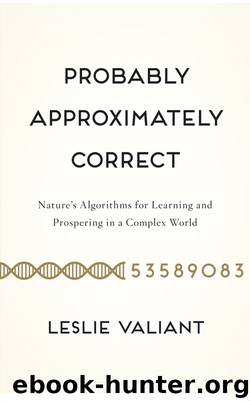Probably Approximately Correct by Valiant Leslie

Author:Valiant, Leslie
Language: eng
Format: epub, mobi
Publisher: Basic Books
6.6 Evolution as a Form of Learning
To see evolution as a form of learning we view the genome in evolution as corresponding to the hypothesis in learning. The performance of the genome corresponds to its expected closeness to ideal behavior, where the expectation is taken over the distribution of experiences the world offers. The goal is to show that if ideal behavior can be represented by a function in an appropriate class, then evolution toward that ideal behavior will occur by means of an evolution algorithm. The course of evolution corresponds to the course of a learning algorithm converging toward a target function.
Returning to the example of the evolution of input functions for a fixed set of proteins, let x1,…, xn be the concentrations of the proteins p1,…, pn, and, for simplicity, let each take only the values +1 or −1, to represent respectively whether they are present or not. For the seventh protein p7 , for example, some function g7 (x1,…, xn) will regulate its production. Whether any will be produced will depend on which one of the 2n combinations of −1, +1 values of the x1,…, xn holds.
This kind of function, which takes and returns yes/no values, is called a Boolean function. Boolean functions, even for moderate numbers of variables, may be very complex, and only a very small fraction of them, those with short descriptions, can be represented in practice in this world, let alone learned or evolved. For the sake of argument let us suppose that it is the class of disjunctions, of which an instance is
g7(x1,…, xn) = x2 or x4 or x11,
that are evolving. Some disjunctions in this class may be more beneficial to the owners than others in that environment. The target of a particular evolutionary pursuit would be the disjunction that defines ideal behavior.
The central question then is whether for some useful class of ideal functions, such as disjunctions, there is a resource-efficient Darwinian mechanism that, when started from an arbitrary member of the class will evolve toward the ideal function.12 To formulate this question more precisely a computational model along the lines of the PAC model with the ideal function as target, and constrained additionally by the limitation of Darwinian feedback, is needed.
Download
Probably Approximately Correct by Valiant Leslie.mobi
This site does not store any files on its server. We only index and link to content provided by other sites. Please contact the content providers to delete copyright contents if any and email us, we'll remove relevant links or contents immediately.
Sapiens: A Brief History of Humankind by Yuval Noah Harari(14308)
Sapiens by Yuval Noah Harari(5316)
Pale Blue Dot by Carl Sagan(4944)
Homo Deus: A Brief History of Tomorrow by Yuval Noah Harari(4867)
Livewired by David Eagleman(3721)
Origin Story: A Big History of Everything by David Christian(3664)
Brief Answers to the Big Questions by Stephen Hawking(3389)
Inferior by Angela Saini(3291)
Origin Story by David Christian(3167)
Signature in the Cell: DNA and the Evidence for Intelligent Design by Stephen C. Meyer(3097)
The Gene: An Intimate History by Siddhartha Mukherjee(3071)
The Evolution of Beauty by Richard O. Prum(2961)
Aliens by Jim Al-Khalili(2801)
How The Mind Works by Steven Pinker(2768)
A Short History of Nearly Everything by Bryson Bill(2653)
Sex at Dawn: The Prehistoric Origins of Modern Sexuality by Ryan Christopher(2498)
From Bacteria to Bach and Back by Daniel C. Dennett(2459)
Endless Forms Most Beautiful by Sean B. Carroll(2439)
Who We Are and How We Got Here by David Reich(2412)
